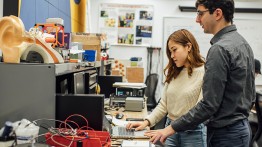Vibration and Acoustics
The Vibrations and Acoustics Laboratory is a 590 square feet laboratory for research and educational activities. The laboratory offers opportunities for hands-on, project-based learning and is used in the Mechanical Vibrations (ME301), Advanced Mechanical Vibrations (ME401), Musical Instrument Design (EID/ME116), and interdisciplinary Acoustics, Vibration and Noise Control (EID260) courses. The laboratory and its various equipment are used in the Mechanical Vibration and Experimentation courses so students gain practical experience with accelerometers and data acquisition to characterize dynamic properties of structures. A practical vibration measurement experiment was incorporated into the undergraduate ME curriculum where students create their own LabVIEW virtual instrument, use vibration instrumentation to study the vibratory behavior of a cantilever beam, and relate theoretical calculations to experimental test results in a written lab report. In the Advanced Vibration class, students perform experimental modal analysis via impact hammer and shaker testing to predict, troubleshoot, and/or optimize structural response characteristics. Examples of past student projects include: designing base excitation demonstrations, analyzing string vibration, and studying the vibration of our AACE Lab embroidery machine. Students are encouraged to approach real-world projects in their environment, such as the vibration of an atomic force microscope, overhead projector vibration in our building’s auditorium, vibration of laboratory exhaust fans and vibration of our building’s cantilevered stairwell.
Extensive testing equipment and instrumentation includes various modal impact hammers, ICP force sensors, signal conditioners, five electrodynamic shakers, and PCB and Bruel & Kjaer seismic, tri-axial, and uni-directional accelerometers. The laboratory is equipped with LabVIEW software including the Sound and Vibration Suite, National Instruments data acquisition devices, seven PC computer workstations and four laptops for remote data acquisition. A grant from the Brooks Family expanded the testing and data acquisition capabilities to include a state-of-the-art, 16-channel LMS SCADAS data acquisition system.
The Vibration and Acoustics Laboratory includes a 520 cubic foot full-coverage anechoic chamber, Larson-Davis 831 and Extech sound level meters, and Bruel & Kjaer and PCB Piezotronics measurement grade microphones. Various audio and sound analysis software and equipment, such as ProTools MBox computer audio workstations, 5000W JBL Professional sound system, and Mackie studio monitor and console, facilitate research projects in acoustics, audio, and music. The laboratory offers opportunities for interdisciplinary projects with engineering, art, and architecture. Current and past projects include environmental noise studies, troubleshooting HVAC noise problems, architectural acoustics, and musical instrument design. An Excel spreadsheet is used to monitor and track equipment usage.






